Any information contained on this Website is not legal advice and should not be treated as such. You should always contact an attorney for help with your specific legal needs and issues. We may also earn a commission when you click links to our partners and purchase goods or services. For more information, read our Disclaimers Policy.
Understanding What is SEO Content Creation: Your Path to Organic Growth
What is SEO content creation is the process of developing website content specifically designed to rank high in search engines while providing genuine value to your target audience. It combines strategic keyword research, user-focused writing, and technical optimization to attract organic traffic that converts into customers.
Quick Answer:
- SEO content creation = Creating content that ranks in Google AND serves real user needs
- Core elements: Keyword research, quality writing, on-page optimization, user intent matching
- Goal: Drive qualified organic traffic that converts to leads and sales
- Timeline: Typically 6-12 months to see significant ranking improvements
- Key success factors: E-E-A-T (Experience, Expertise, Authoritativeness, Trustworthiness)
Today's SEO requires a sophisticated understanding of user intent, search algorithms, and business goals. It's about creating content that makes both Google's algorithms and your potential customers say, "this is exactly what I was looking for."
Research shows that genuinely helpful content can drive immense growth, with one brand increasing organic traffic by roughly 600 times over two years. This success comes from solving real problems, not gaming the system. For any business aiming for sustainable online growth, mastering SEO content creation is no longer optional--it's essential.
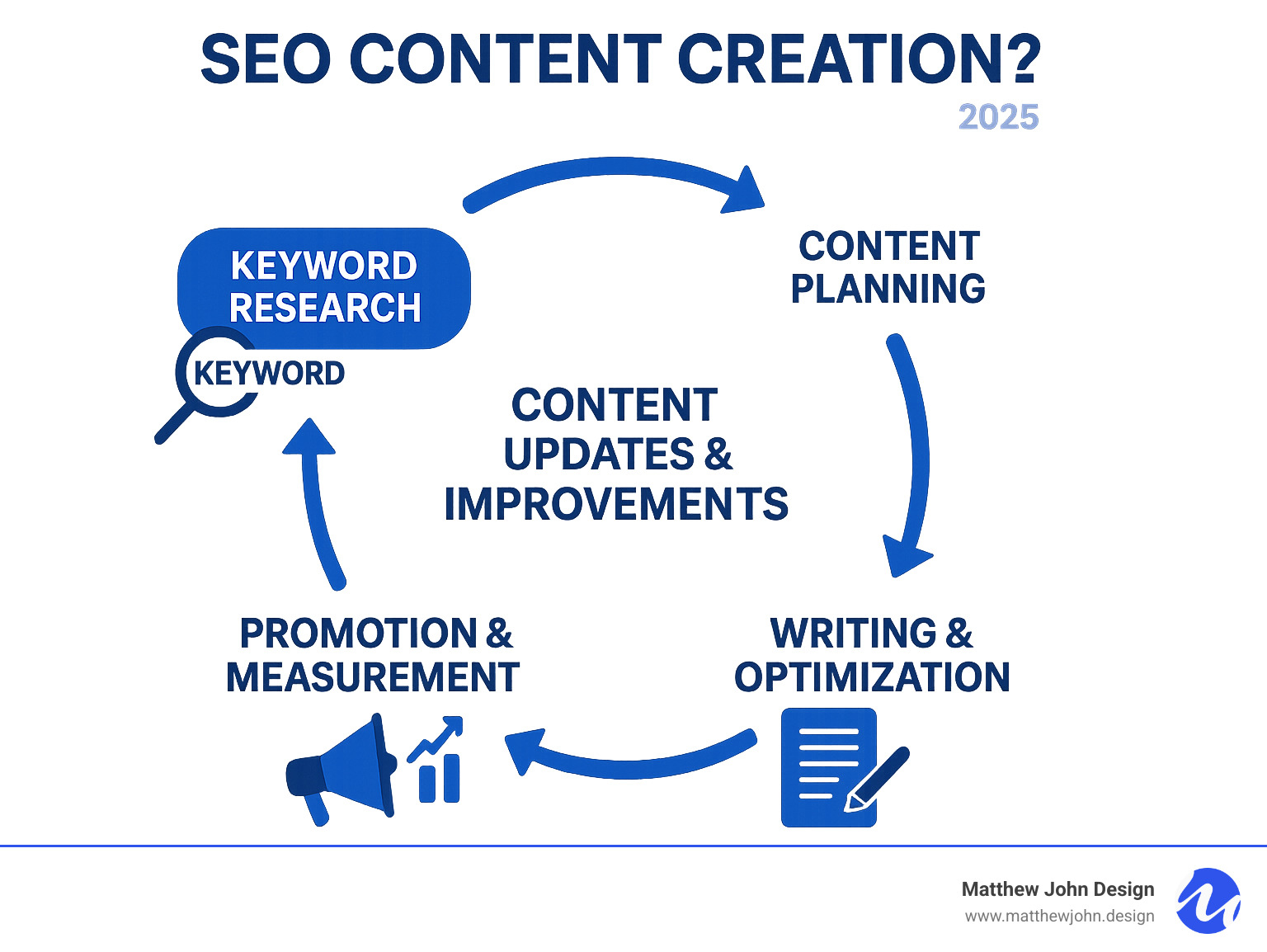
What is SEO Content & Why It's a Game-Changer
SEO content creation brings together two powerful forces: Search Engine Optimization (SEO) and great content. SEO guides search engines to your site, while content is the valuable information you provide. Combined, it's the process of creating online material—like blog posts or videos—that pleases both search engines and people. The goal is to rank high in search results, attracting quality traffic without paying for every click.
This is a game-changer for your business because the benefits add up:
- Increased Visibility: When your content ranks well, more people find your business, leading to more organic traffic and less ad spend.
- Quality Lead Generation: Good SEO content attracts visitors who are already looking for what you offer, making them more likely to become customers.
- Brand Authority: Consistently sharing helpful, well-researched content builds your brand's reputation as a trusted expert.
- Audience Trust: When people find your content useful, they begin to trust your brand, encouraging repeat visits and engagement.
Smart SEO content can achieve incredible results. This kind of visibility isn't luck; it's strategy. And it's not just about traffic—SEO content can help brands increase product sales revenue significantly. Great content isn't just a marketing expense; it's a powerful driver of bottom-line growth.
The Goal: Attracting High-Quality Organic Traffic
The core of what is SEO content creation is attracting high-quality organic traffic—visitors who are genuinely interested in what you offer. This comes down to understanding user intent, or the "why" behind a search query. We create content that matches the four main types of search intent:
- Informational: The user wants answers or to learn something (e.g., "how to make pancakes").
- Navigational: The user is looking for a specific site (e.g., "Matthew John Design Webflow").
- Commercial: The user is researching before a purchase (e.g., "best office chair reviews").
- Transactional: The user is ready to buy or take action (e.g., "buy noise-canceling headphones").
By creating content that directly addresses these intents, we attract the right audience and guide them smoothly through the customer journey. Want to learn more about guiding users? Check out our article on CRO Strategies for SaaS Companies Using Webflow.
Types of SEO Content That Win
What is SEO content creation is incredibly versatile. A mix of content formats helps you reach a wider audience and satisfy different search intents. Here are some of the most effective types:
- Blog Posts: Versatile articles that answer common questions and build authority.
- Long-form Guides: In-depth resources that establish your site as a go-to expert.
- Product Pages: Crucial for transactional intent, optimized with details about what you sell.
- Videos: Highly engaging and can appear directly in search results.
- Infographics: Shareable visual summaries of complex data or processes.
- Glossaries: Define industry terms to help users and boost your site's expertise.
- Case Studies: Build trust by sharing real-world examples of your success.
- Pillar Pages: Broad pages covering a major topic, linking to more specific "cluster" articles.
- Listicles: Easy-to-read, shareable posts (e.g., "10 Ways to Save Money").
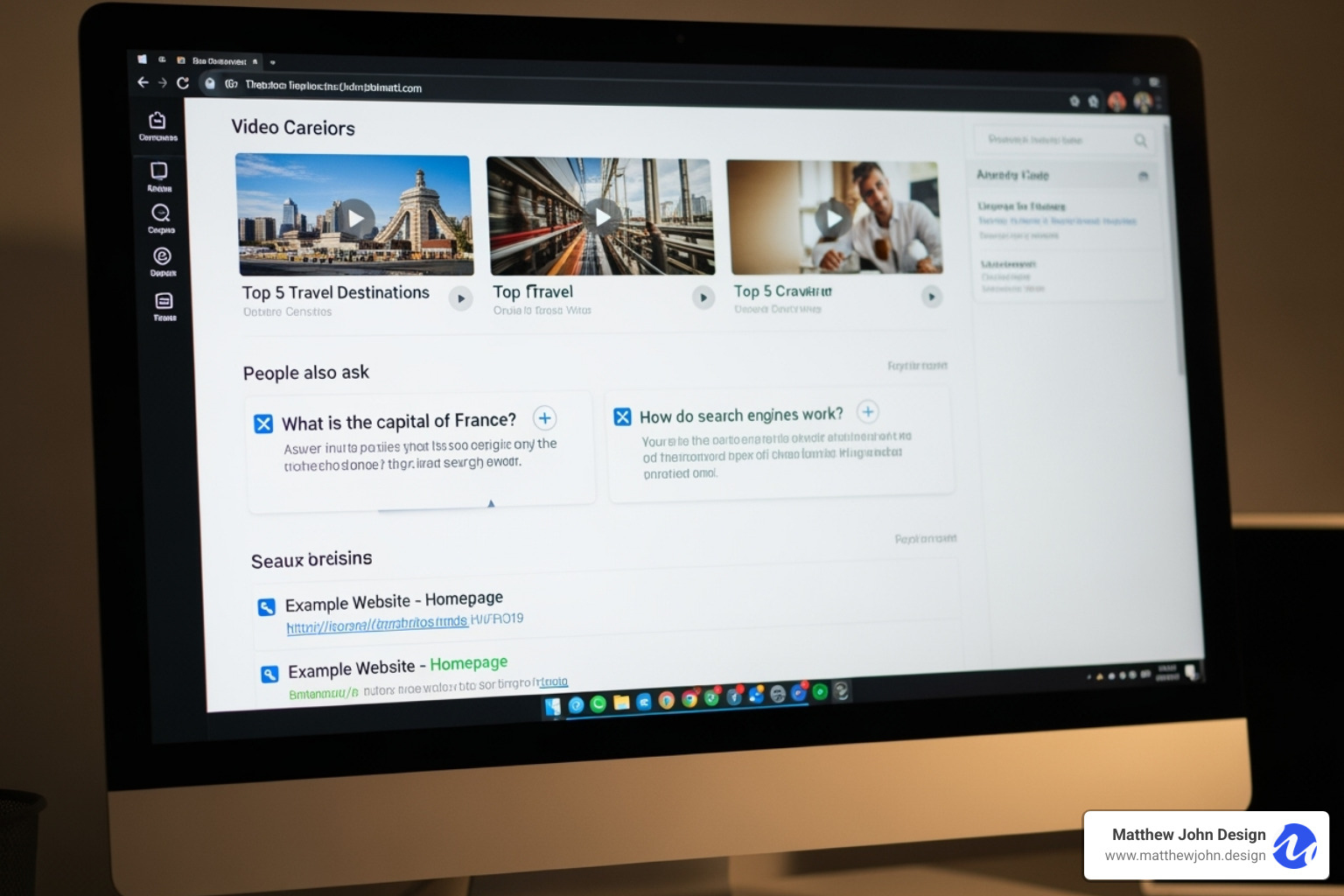
The Core Process: What is SEO Content Creation in Practice?
Effective SEO content creation follows a structured, repeatable process. Think of it like building a house: you need a clear plan and a skilled team to ensure your content is not just good, but findable. It's a team sport where everyone plays a vital role.
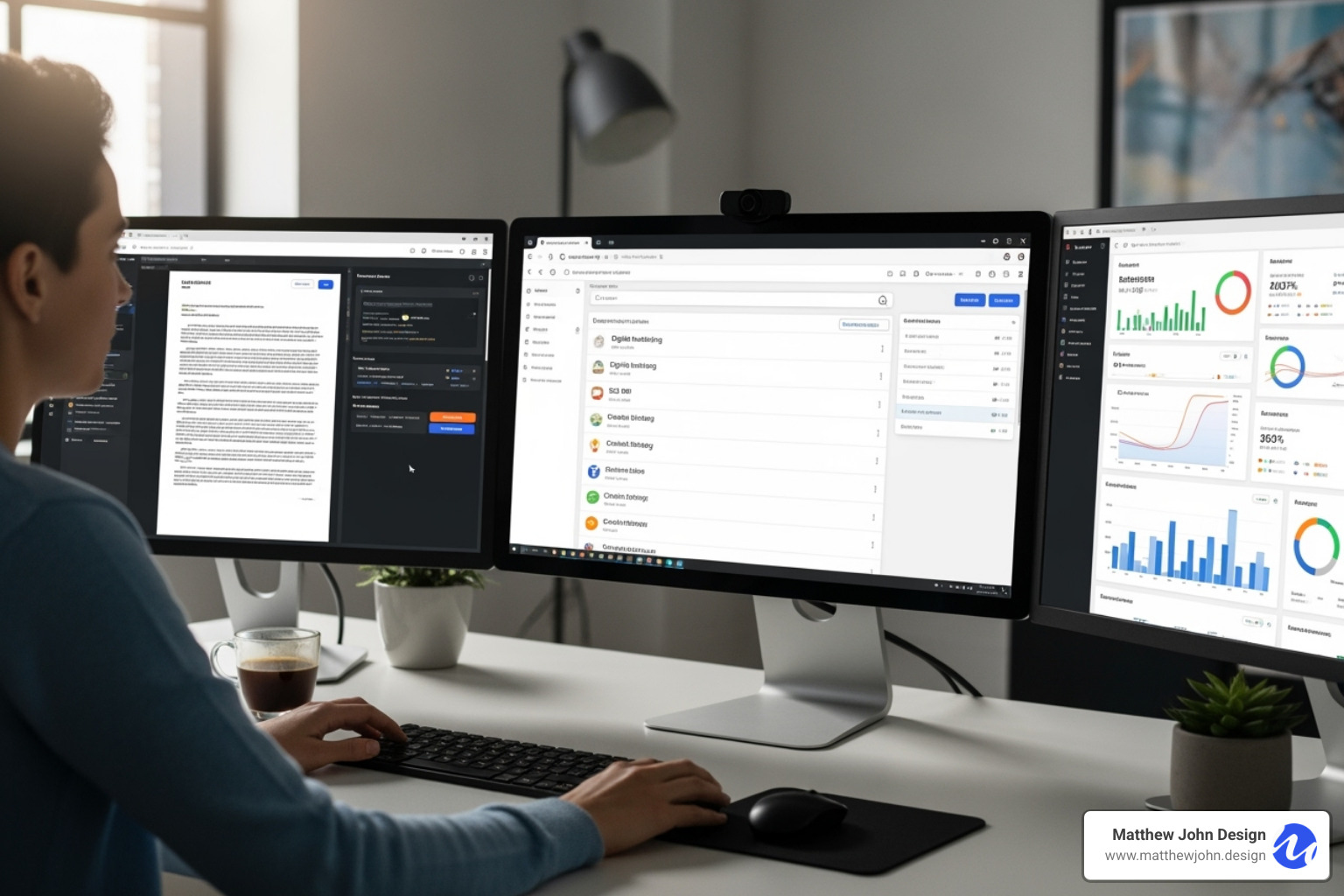
At Matthew John Design, we weave SEO into every step of our content creation process. A dedicated team ensures your content is both engaging and optimized for visibility:
- SEO Strategist: The architect who handles keyword research, competitor analysis, and aligns content with search intent.
- Content Writer: The wordsmith who crafts high-quality, engaging content that speaks to your audience.
- Editor: The quality control expert who ensures accuracy, readability, and consistency.
- Designer/Developer: The specialist who ensures content looks great, functions flawlessly, and meets technical SEO standards.
- Project Manager: The coordinator who keeps the project on track and ensures deadlines are met.
- Operations/Publishing Specialist: The technician who handles formatting, image optimization, and publishing.
- Distribution Specialist: The promoter who spreads the word across social media, email, and other channels.
Step 1: Keyword Research and SERP Analysis
Every SEO content journey begins with keyword research. This is about understanding the language your audience uses to find solutions. We aim to uncover keywords that are relevant, have sufficient search volume, and offer a realistic chance to rank.
We analyze:
- Search volume: How many people are searching for this phrase monthly?
- Keyword difficulty: How competitive is it to rank for this keyword?
- Long-tail keywords: Longer, specific phrases (e.g., "best noise-canceling headphones for air travel") that attract highly motivated searchers.
- Search intent analysis: Why is someone searching? Are they looking for information, ready to buy, or just browsing?
- Competitor analysis: What are rivals ranking for? Where are the opportunities for us to do better?
- SERP features: Does Google show videos, "People Also Ask" boxes, or images? This guides our content format.
Industry-leading tools tap into databases of over 25 billion keywords, giving us a vast playground for finding the right terms. We use these powerful tools to find, select, and strategically place keywords throughout your website. To streamline this step, we also use our own SEO Content Creation Tool to pinpoint opportunities.
Step 2: Understanding Quality: The Heart of What is SEO Content Creation
With keywords identified, the focus shifts to creating high-quality content. This means putting the user first. Google's algorithms reward content that genuinely helps people. A key measure of quality is E-E-A-T:
- Experience: Does the author have real-world experience with the topic?
- Expertise: Is the content written by a knowledgeable expert?
- Authoritativeness: Is your website seen as a go-to source for this information?
- Trustworthiness: Is the content accurate, transparent, and reliable?
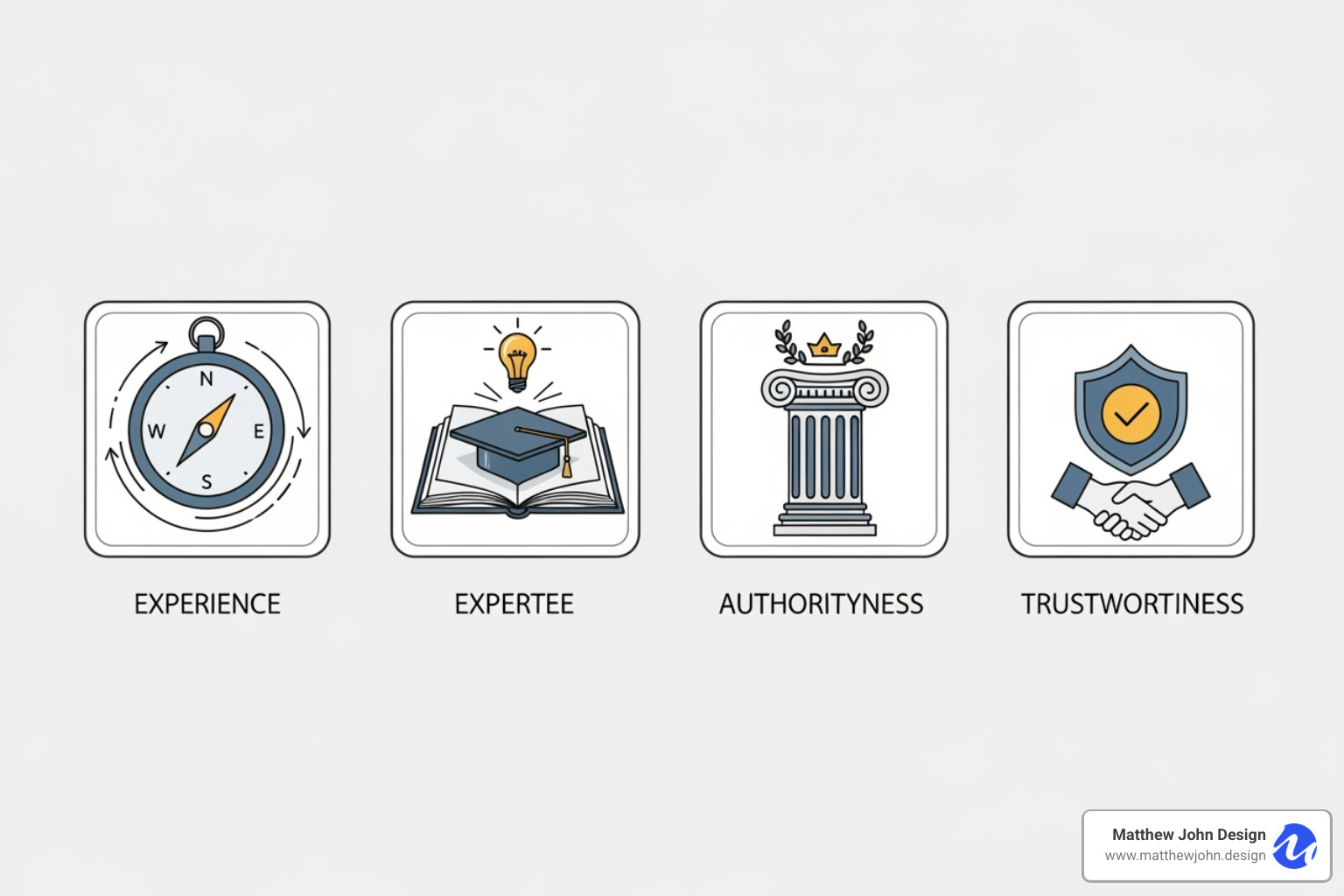
E-E-A-T is a critical factor Google uses to assess page quality, especially for "Your Money or Your Life" (YMYL) topics that can impact a person's health, finances, or safety. To demonstrate strong E-E-A-T, we focus on:
- Original research: Conducting surveys, analyzing data, or running experiments to find fresh insights.
- Adding unique value: Going beyond what's already out there by sharing personal stories, creating custom templates, or building more comprehensive resources.
- Readability: Using clear language, short sentences, and bullet points to make content easy to digest.
Step 3: Strategic Keyword Integration in All Content Formats
Next, we strategically weave keywords throughout the content. This is "on-page SEO"—optimizing each page to rank higher and attract relevant traffic.
For Written Content:
- Title tags: The page's headline in search results. It should contain the primary keyword to signal the page's topic.
- Meta descriptions: Your sales pitch in search results. Including the keyword can improve click-through rates.
- H1 and heading structure: The main title (H1) must include the primary keyword. H2s and H3s should include secondary keywords to organize content and improve readability.
- URL slugs: Keep URLs short, descriptive, and include the focus keyword (e.g.,
yourdomain.com/what-is-seo-content-creation). - Body copy: Include the primary keyword in the first 100 words, then sprinkle related keywords naturally throughout the text. Avoid keyword stuffing.
For Image Optimization:
- Descriptive file names: Use clear, keyword-rich names before uploading (e.g.,
seo-content-creation-process.png). - Alt text: Add descriptive alt text to every image. This helps search engines and screen readers understand the image content.
For Video SEO:
- YouTube Optimization: Add target keywords to the video's title and description on YouTube.
- Embed Videos: Embed optimized videos on relevant webpages to boost engagement.
- Transcripts: Provide text transcripts to improve accessibility and give search engines more content to crawl.
For our Webflow clients, it's important to note that Webflow only supports background videos up to 30 MB and does not provide native video hosting for larger files. For larger videos, we recommend third-party hosting solutions like YouTube, Vimeo, or Vidzflow. Learn more in our guide to Webflow Video SEO.
| Content Element | Primary Keywords | Secondary/Tertiary Keywords |
|---|---|---|
| Written Content | Title Tag, H1, URL, First 100 words | H2/H3s, Body paragraphs, Conclusion |
| Images | File Name, Alt Text | Alt Text |
| Videos | Title, Description (on hosting platform) | Description, Transcript, Tags (on hosting platform) |
Beyond the Page: Technical SEO's Role in Content Visibility
Even the most brilliant content can remain hidden if a website isn't technically sound. Technical SEO is the invisible infrastructure that helps search engines find, understand, and display your content. It's the powerhouse ensuring your hard work gets the spotlight it deserves.
While content creation focuses on words and visuals, technical SEO focuses on the website's mechanics. Here are the key elements that impact your content's visibility:
- Site Structure: A well-organized site acts like a library, helping Google understand how content is related. We use pillar pages (broad topics) and topic clusters (specific articles) connected with internal links to guide both users and search engine crawlers.
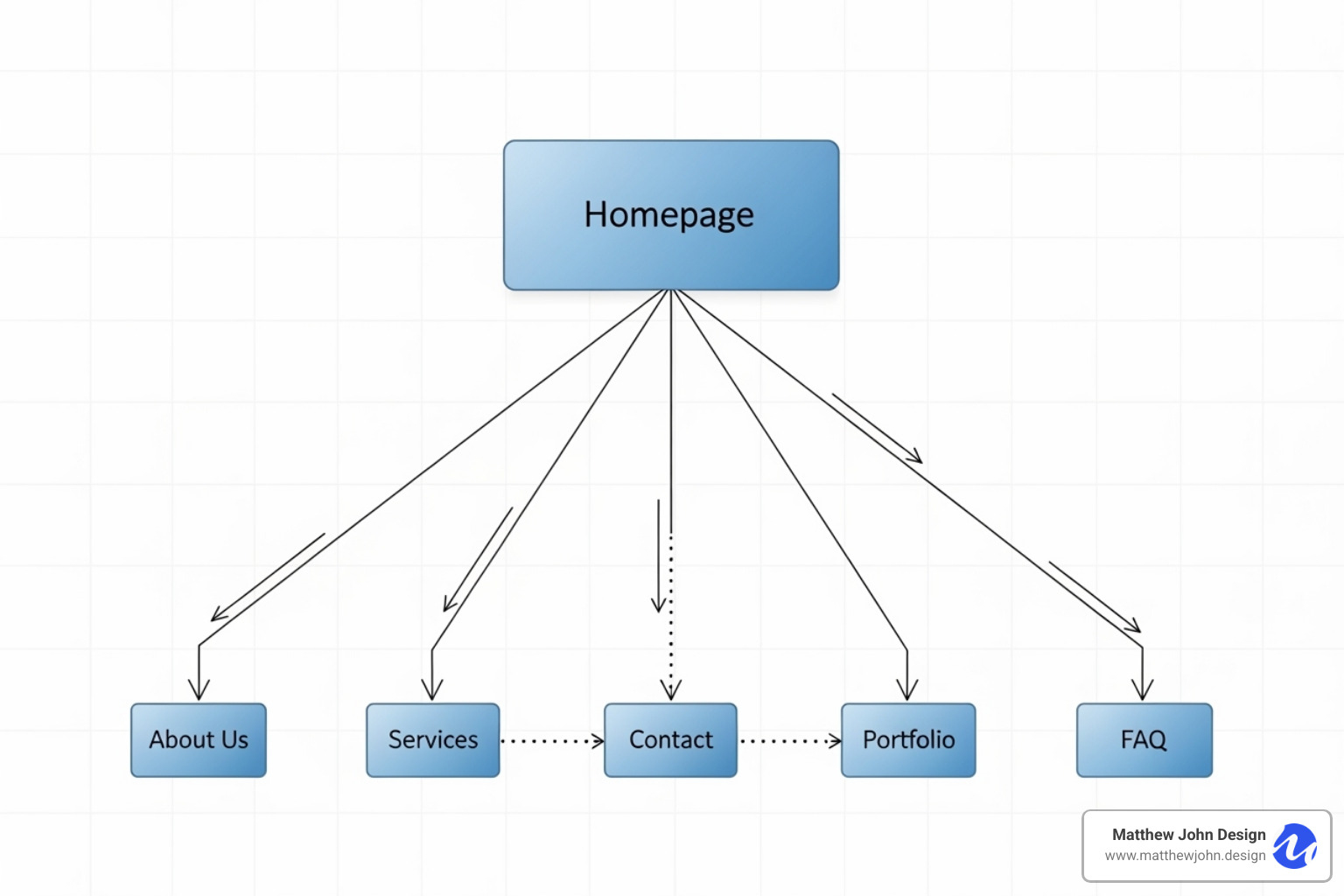
- Crawlability and Indexability: We ensure search engine crawlers can easily "read" and "list" your content by fixing issues like broken links or misconfigured robots.txt files that might cause them to miss your pages.
- Mobile-Friendliness: With most users browsing on phones, a mobile-friendly design is essential. Google prioritizes sites that offer a great mobile experience, which is why our Webflow sites are built to be perfectly responsive.
- Page Speed: Slow-loading pages hurt user experience and rankings. We optimize images, code, and server response times to ensure content loads in a flash. This directly impacts Core Web Vitals, Google's metrics for user experience.
- Internal Linking: Beyond structuring your site, thoughtful internal links spread authority between your pages, signaling to Google which ones are most important. They also keep users engaged by helping them find more of your valuable content.
Building on Webflow provides a fantastic head start. You might be wondering, Is Webflow Good for SEO? The answer is yes! Its clean code and customizable settings create a strong technical foundation for content visibility.
Amplifying Your Reach: Content Promotion, Measurement, and Maintenance
Creating great content is just the beginning of what is SEO content creation. To fulfill its purpose, your content needs active promotion, careful measurement, and ongoing maintenance.
Content PromotionOnce published, content needs a push. Use social media to share engaging snippets that spark curiosity. Leverage email marketing to reach your most receptive audience. Build links by creating valuable content that other sites will want to reference and by reaching out to relevant publications.
Performance MeasurementTracking performance ensures your strategy is based on data, not guesses. Use tools like Google Analytics and Google Search Console (GSC) to monitor key metrics:
- Organic Traffic: How many visitors find your content through search?
- Keyword Rankings: Which search terms are bringing people to your site?
- Conversion Rate: Are visitors taking desired actions (e.g., signing up, requesting a quote)? This shows the true business impact.
- Engagement Signals: Metrics like time on page and bounce rate signal content quality to Google.
Content MaintenanceContent can experience "decay" as information becomes outdated. Regular maintenance is crucial for long-term success. Most companies spend approximately 20-30% of their efforts updating old content, an investment that often pays dividends.
- Content Updates: Keep material fresh by adding new statistics, expanding sections, or updating screenshots. A simple refresh can revive a page's rankings.
- Re-optimization: Revisit your keyword strategy for older content. Target new long-tail keywords or optimize for new SERP features to maintain a competitive edge.
What is SEO content creation isn't a "publish and pray" strategy. It's an ongoing process of creating, promoting, and nurturing your content over time.
Frequently Asked Questions about SEO Content Creation
How long does it take to see results from SEO content?
SEO is a long-term strategy that requires patience. Typically, you can expect to see significant results in 6 to 12 months.
This timeline is influenced by several factors:
- Website Authority: A newer site or one with lower authority will take longer to gain Google's trust compared to an established one.
- Competition: Ranking in a crowded industry requires more time and effort to break through.
- Content Quality & Consistency: Creating comprehensive, helpful content and publishing it consistently can accelerate your results.
Think of it as building a sustainable asset that will deliver value for years to come.
Should I update old content or create new content?
The short answer is both! A balanced approach works best.
Updating old content is highly efficient. It builds on existing authority and can deliver faster ranking improvements. Prioritize updating high-potential pages, such as those ranking on page two, those with declining traffic, or those targeting newly popular topics.
Creating new content is essential for expanding your reach. You need fresh content to target new keywords, address different user intents, and build topic clusters that support your pillar pages.
A practical approach is to dedicate about 20-30% of your content efforts to updating existing pieces and the rest to creating new, valuable content.
What makes content "high-quality" for Google?
High-quality content is content that real users find valuable. It's not about gaming the system; it's about serving your audience better than anyone else. Key factors include:
- Satisfying User Intent: Directly answering the user's query or solving their problem.
- Demonstrating E-E-A-T: Showcasing Experience, Expertise, Authoritativeness, and Trustworthiness.
- Accuracy and Research: Providing well-researched, factual information with credible sources.
- Unique Value: Offering something new, like original research, unique perspectives, or a more comprehensive guide than competitors.
- Structure and Readability: Using clear headings, short paragraphs, and lists to make the content easy to consume on any device.
As Google's advice goes, "make pages for users, not search engines." When you prioritize your audience, Google typically rewards that focus with better rankings.
Conclusion: Start Creating Content That Ranks and Converts
We've explored what is SEO content creation from keyword research to technical optimization. The key takeaway is that this process is a blend of art and science. The science is the data-driven research and optimization; the art is crafting stories that solve real problems for your audience.
Every piece of content is a bridge between your business and a potential customer--it must be both findable by search engines and valuable to people.
Focus on user value. This is the golden rule. When you genuinely help people, search engines have gotten remarkably good at recognizing and rewarding that effort.
Consistency is your secret weapon for long-term organic growth. It's about showing up regularly and staying committed, even when results take time. While it can take 6 to 12 months for significant ranking improvements, the outcome is sustainable. Unlike paid advertising that stops when you stop paying, great SEO content works for you month after month.
At Matthew John Design, we've seen how powerful this approach can be. We specialize in building powerful Webflow sites and executing data-driven content strategies that get results. We understand that your website isn't just a digital business card; it's a dynamic tool for attracting the right people, engaging them with valuable content, and guiding them toward becoming loyal customers.
Ready to transform your online presence and start creating content that actually works? Learn more about our SEO Content Links Services and find how we can help your business rank higher and convert more visitors into customers.

